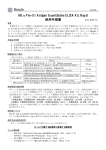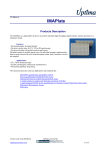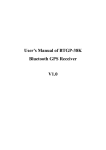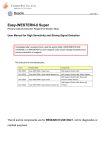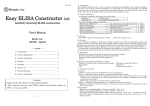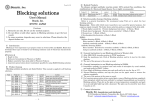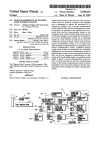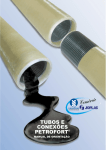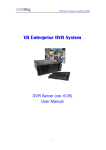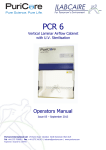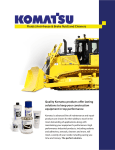Download Beacle
Transcript
Beacle ver. 1.02E User’s Manual HBs HBs PrePre-S1 Quantitative Kit, Kit, high sensitivity Background and Features of “HBs PrePre-S1 Quantitative Kit” Kit” Three types of hepatitis B virus surface antigen (HBsAg), L-, M-, and S-proteins are known. The L-protein is composed of S, Pre-S2, and Pre-S1 domains, and the M-protein is composed of S, Pre-S2 domains, and the S-protein S domain alone. L-protein plays an important role in HBV infection to human hepatic cells, where Pre-S1 region is the key for recognizing human hepatic cells. The “HBs Pre-S1 Quantitative Kit, high sensitivity” enables to explore the human hepatic cell recognizing activity of HBsAg and the HBV infectivity by determining Pre-S1 antigens. Features The world only one detection system for PrePre-S1 antigen of HBV Determination of Prere-S1 activity in human serum possible High sensitivity (range : 0.2~ 0.2~10 nUnit/ nUnit/mL Unit/mL)* mL)* *:1 nUnit is defined as the Pre-S1 activity possessed by 1ng of standard antigen provided to the kit. Related products The related products are listed in the below table. We provide a variety of HBV related product. Product# BCL-AGS-01 BCL-AG-001 BCL-AB-001 BCL-AB-002 Product name Content 100 µg HBsAg L-protein ST, Pre-S1 and Pre-S2 recombinant HBsAg displaying Pre-S1 and Pre-S2 activities, suitable as control antigen 100 µg HBsAg L-protein recombinant HBsAg displaying all S- Pre-S1 and Pre-S2 regions, suitable as control antigen. 100 µg Anti Pre-S1 antibody, mouse-mono-1 mouse monoclonal antibody. ELISA can be with combination of Pre-S1 antibody mouse-mono-2 100 µg Anti Pre-S1 antibody, mouse-mono-2 mouse monoclonal antibody suitable for western Blotting and ELISA. Other Related products are also available, visit our Website; www.beacle.com. The principle and outline of ass assay The key components of the kit are two anti-Pre-S1 mouse monoclonal antibodies and Pre-S1 antigen. So-called sandwich system is employed, where antibody A captures the antigen on the microplate surface, and the captured antigen is detected by another antibody, antibody B which is labeled with HRP. Finally the amount of HRP attached was determined using chromatic substrate. Approximate time required for an assay is as follows; ① IgG coating: 120 min (or overnight) → ② Plate blocking: 60 min (or overnight) → ③ Reaction with capture IgG: Overnight → ④ Reaction with detection IgG: 120 min → ⑤ Chromatic reaction : 20 min You need additionally times for reagent preparing, pipetting, sampling, washing, measuring etc. The definition of PrePre-S1 antigen activity There is not established definition to express Pre-S1 antigen activity. In this kit, we expressed the Pre-S1 antigen activity as follows; the Pre-S1 activity of 1 nUnit equals to that of 1 ng of standard antigen (see below) that is provided in the kit. According to this definition, the detection range of the kit is from 0.2 to 10 nUnit/mL. To imagine the sensitivity of the kit and the unit system employed here, we give you following information; one ng/mL of the recombinant HBsAg L-protein (BCL-AG-001) shows Pre-S1 activity of approximately 1 nUnit/mL and S antigen activity of about 1/2 of standard human serum obtained from infected patients. Thus, suppose a human serum sample has Pre-S1 activity of about 1/10 of S antigen activity, the kit has great chance to detect the Pre-S1 activity. Storage condition and stability All components can be stored at 4℃. At the condition, all reagents are stable for at least 12 months. Beacle ver. 1.02E Materials and Reagents Kit composition The kit contains following materials. Please ensure that all materials are provided in the kit. ・ Capture IgG (anti-Pre-S1): 120 µL (50 µL/96-well plate) ・ Detection IgG (HRP labeled, anti-Pre-S1): 25 µL (10 µL/96-well plate) (Because of small amount, collect all liquid in the bottom of tube by centrifugation before use) ・ Standard antigen (lyophilized form, recombinant antigen): 30 µg/tube ・ Coating Buffer: 25 mL (10 mL/96 well plate) ・ Blocking Agent: 0.2g x 3 (powder, 0.2 g dissolved in 20 mL PBS is enough for 96-well plate) ・ Dilution solution for Detection IgG: 25 mL (10 mL/96-well plate) ・ 20 x PBS: 25 mL ・ 20 x PBS-T: 25 mL ・ Chromogenic Reagent: 25 mL (light shield)(10 mL/96-well plate) ・ Stop Solution: 15 mL ・ Microplates (96-wells, split type): two plates ・ User’s manual Equipments required for the assay and Reagents not provided by the kit ・ Microplate reader (equipped to measure absorbance at 450 nm) ・ Micropipettes (for the handling of standard antigen and samples, we recommend to use tips of protein low bind type) ・ Micro tubes (for the handling of standard antigen and samples, we recommend to use tubes of protein low bind type) ・ Plastic tubes, bottles, plate sealers (or plastic films) ・ Multi (8-) channel pipette ・ Distilled water or pure water Assay Procedure <Preparation> Preparation> Dilute “20 x PBS” and “20 x PBS-T” to 20-fold with distilled water. To do so, first return the bottles containing concentrated solution to room temperature for complete dissolution (chilled concentrated buffers often contain depositions of salts). Take 10 ml of the concentrated solutions and add 190 mL of distilled water. The diluted buffer solution of 200 mL each is enough to treat one 96-well plate, and can be stored at 4℃. Before usage, the diluted solutions should be returned to room temperature. <Coating of capture IgG to microplate microplate> plate> 1. Add 50 µL of the capture IgG to 10 mL of Coating Buffer and mix well. About 10 mL is required to coat one 96-well plate. 2. By using an 8-channel pipette, add 100 µL of the diluted capture IgG to each well. 3. Let it stay at 37°C for 120 min( or at 4°C for overnight) after covering the plate by plate sealer. <Blocking> Blocking> 1. Disolve 0.2 g of Blocking Agent powder by 20 mL of PBS and mix well. This blocking solution of 20 mL is enough to treat one 96-well plate. 2. Remove the diluted Capture IgG solution from the plate by decantation followed by gentle tapping on the paper towel. 3. Add 200 µL of the blocking solution to each well by using an 8-channel pipette. Incubate at 37 °C for 1 hrs (or at 4°C for overnight) after covering the plate by plate sealer. 4. It is recommended that preparation of standard antigen and sample solutions should be performed during this incubation time. [note] note] Please remove the diluted Capture IgG solution completely, and do not dry the well after the solution removal to avoid inconsistent measurement. <Preparation of standard solutions> 1. Prepare ten low protein binding tubes. The standard antigen adsorbs to plastic tubes, so that the Beacle ver. 1.02E standard antigen solution must be diluted in the protein low bind tubes. 2. The standard antigen is provided as a lyophilized form in a tube. Add 100 µL of distilled water into the tube and mix well to dissolve the antigen completely. Be careful when open the tube because the lyophilized power may be attached on the cap of the tube. The completely dissolved antigen solution makes the concentration of 300 µg/mL or 300 µUnit/mL. This This concentrated standard antigen solution can be stored at 4°C 4 for at least 3 months. months. 3. Put 870 µL of PBS into one of the low protein bind tubes, add 30 µL of the concentrated standard solution and mix well immediately using a vortex. After mixing we recommended to wash the tip by repeated pipeting in the diluted solution to achieve complete transfer of the concentrated standard solution. The final concentration of the standard solution is 10 µUnit/mL. 4. Put 475 µL of PBS into one of the low protein bind tubes, add 25 µL of the above diluted standard solution at 10 µUnit/mL and mix well immediately using a vortex. After mixing we recommended to wash the tip by repeated pipeting in the diluted solution tube to achieve complete transfer of the standard solution. Likewise, prepare the series of standard solutions as indicated in below table. PBS amount 475 μL 950 μL 600 400 400 600 400 600 400 μL μL μL μL μL μL μL Antigen solution for dilution + 10μUnit/mL 25 μL + 500 nUnit/mL 50 μL = = + + + + + + + = = = = = = = 25 nUnit/mL 10 nUnit/mL 5 nUnit/mL 2.5 nUnit/mL 1.0 nUnit/mL 0.5 nUnit/mL 0.2 nUnit/mL 400 400 400 400 400 400 400 μL μL μL μL μL μL μL Final Conc. 500 nUnit/mL 25 nUnit/mL 10 5 2.5 1 0.5 0.2 0.1 nUnit/mL nUnit/mL nUnit/mL nUnit/mL nUnit/mL nUnit/mL nUnit/mL STD I.D. (Serum) STD① STD② STD③ STD④ STD⑤ STD⑥ STD⑦ 5. To draw the standard curve, standard solution from STD① to STD⑦ are used. 6. Human serum components influence the assay. When Pre-S1 activity of human serum or plasma is determined, it is recommended to add serum (or plasma) to the standard antigen solution to minimize the influence. To do so, dilute the standard solution (10 µUnit/mL) to 500 nUnit/mL by using HBsAg-negative serum (or plasma) instead of PBS. Further dilution should be done by PBS. [note] It is possible that the antigen adsorbs to plastic tips during pipetting procedure especially in diluted standard solutions. Therefore, we recommend to use low protein binding tips or not to dip tips too deep in the standard solution when the concentration is below 30 nUnit/mL. <Preparation of sample solutions> solutions> 1. Dilute the sample solution by PBS so that the expected activity is within the measurable range (0.2 ~10 nUnit/mL). 2. When Pre-S1 activity of a sample is unknown, please prepare multiple samples with different dilution factors. 3. When human serum (or plasma) is assayed, serum (or plasma) sample should be diluted more than 100-fold by PBS to prevent the effect of serum (or plasma) components. [note] 1. Measurement of highly contaminated samples may not be accurate. It is recommended to ensure the accuracy by using samples which is added by known amount of standard antigen. 2. Please use the low binding tubes to dilute the sample in order to prevent attachment of samples to plastic tubes. 3. We do not guarantee the successful determination of non-human animal species. The addition of rodent serum to standard antigen is known to give inaccurate measurement. <Reaction with capture IgG and antigens> antigens> 1. Remove the blocking solution from the plate by decantation followed by gentle tapping on the paper towel. 2. Wash each well by 200 µL/well of PBS-T three times. Then wash with 210 µL/well of PBS three times. The one cycle of washing procedure is as follows; first add the indicated volume of PBS-T or PBS then remove the solution by decantation followed by gentle tapping on the paper towel. You can also use plate washer machine. 3. In triplicate manner, add 100 µL of sample, standard solutions, or PBS (as the blank) to each well. Beacle ver. 1.02E 4. Cover the plate by plate sealer, and let it stay at 4°C for overnight (more than 15hr). <Reaction with detection IgGIgG-HRP and antigens> antigens> 1. Dilute 10 µL of HRP-labeled detection IgG solution with 10 mL of Dilution solution for Detection IgG. About 10 mL of the diluted detection IgG solution is required to treat one 96 well plate. 2. Remove the sample or standard solution from the plate by decantation followed by gentle tapping on the paper towel. 3. Wash each well with 200 µL/well of PBS-T three times. Then wash with 210 µL/well of PBS three times. The washing procedure is the same as described above. 4. Add 100 µL of the diluted detection IgG to each well by using 8-channel pipette. Incubate for 2 hr at 37°C after covering the plate by plate sealer. <Chromogenic reaction> reaction> 1. Remove the detection IgG solution from each well by decantation followed by gentle tapping on the paper towel. 2. Wash each well with 200 µL/well of PBS-T four times. The washing procedure is the same as described above. 3. Add 100 µL of the chromogenic solution to each well by using an 8-channel pipette, and incubate for 20 min at room temperature in the light-tight container. To obtain reproducible result the incubation time with chromogenic solution must be accurately 20 min. 4. Stop the reaction by adding 50 µL of stop solution. [note] The yellow color generated by the chromogenic reaction diminishes rather quickly. Thus, to obtain accurate determinations, it is important to measure the absorbance soon after the addition of stop solution. <Absorbance measurement and calculation> 1. Measure the absorbance at 450 nm of each well by using a plate reader. 2. Calculate the specific absorbance of each sample or standard by subtracting the blank value. 3. Calculate the best fit curve between the specific absorbance values and the corresponding standard concentrations using 4 parameters logistic model. 4. The concentration of samples can be calculated from the equation of the best fit curve. 5. The calculated concentrations which are out of the range (<0.2 or >10 nUnit/mL) are not reliable. [note] Clean up the bottom of the plate before absorbance measurement to avoid inaccurate determination. <Example of standard standard curve > Below is an example of measurements of standard solutions and resulting standard curve. 3.5 Abs450nm 3.304 1.651 0.785 0.338 0.173 0.080 0.052 3.0 2.5 Abs (450nm) ID STD① STD② STD③ STD④ STD⑤ STD⑥ STD⑦ STD nUnit/ml 10 5 2.5 1 0.5 0.2 0.1 2.0 magnification 0.4 1.5 1.0 0.2 0.5 0.0 0.0 0.5 1.0 0.0 0 2 4 6 8 10 12 STD concentration (nUnit/ml) [note] The above data is an example, and does not guarantee the performance of the kit. due to the difference of the technique and other conditions. Contact Information Beacle, Inc. 5303 Haga, Kita-ku Okayama, 701-1221 Japan. E-mail: [email protected] Website: www.beacle.com The results may differ




